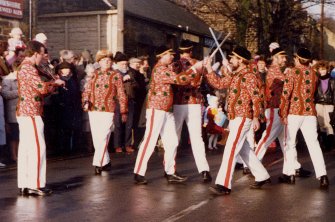|
This
dance belongs in the village of Grenoside on
the north-west edge of Sheffield. It still forms an important
mid-winter ritual for the village when we dance outside the Old Harrow
in Main Street at 11 o'clock on Boxing Day. It has been danced in the
village for many years: the earliest printed account was in the Pall
Mall Gazette in January 1895, there is a photograph dated 1885 and a
written record which probably dates from the mid 1700s. At times it has
seemed that the dance may die, but men
have always sprung up to learn from the old dancers
and to carry on the tradition. Our fiddler's grandfather was in the
team and there are still other family connections with the dance.
Dancers from before the war still live in the village. The dance
continues to evolve: Cecil Sharp's account does not match our present
dance precisely and before the last war the stepping was more elaborate
and the dance was followed by Ring 0' Roses in which each man stepped a
solo.
At that time each man's jacket was different and the
Captain's helmet was covered by a rabbit (or hare?) skin rather than
the fox fur of today. At other times the music has been played on a
melodeon instead of a fiddle, but the four tunes (Drops 0' Brandy,
Roxborough Castle, Wonder Hornpipe and Smash the Windows) remain the
same.
The Captain and the six men dance a series of
figures
which are similar to other long sword traditions and cycle round the
six swords in turn. However
the sequence and style of the dance, the break step between figures,
the songs, the beheading of our captain, the music and the costume make
this dance unique. The 'new' swords of Sheffield Steel date from 1933
and the scarlet paisley jackets with green and red braid and rosettes
were made for the Festival of Britain in 1951. Our iron shod clogs
sound best on good flagstones. We do not dance simply for
the pleasure of it, for beer money or a good day out;
we dance because this dance, this tradition matters to us. We often
speak of 'our' dance but in a sense we belong to it rather than it to
us. It may signify much or little, one thing to one dancer and another
to another, but it marks the season for all of us with a special sense
that we have performed an important rite for ourselves and our
witnesses. For some of us and of the bystanders, the Boxing Day dance
gives a perceptible shove to the turn of the year and encourages
us to believe that winter's dark and cold will again yield to warmth
and light before we give up hope - and reminds us that life follows
death as death follows life.
At other times and places we dance to
share the
dance with friends and to improve our funds, but the Boxing Day ritual
has a meaning of its own. In 1994 we revived the custom of taking the
dance around the village later in the Christmas period. We have not
toured
the 'Big Houses' for miles around over several days as the team used to
do but on the Saturday nearest Twelfth Night we dance at shops and pubs
and houses where the dance is honoured. These days we may be seen in
newer duller jackets because the stature of the dancers has changed
over the last forty years, and because we have so far been unable to
find material to match the splendour of the 1951 jackets. When we dance
indoors on delicate floors we
muffle our clogs with rubber.
The ceremony has been recorded on film and
video, and was
studied in depth in the 1980s.
|
|
|

